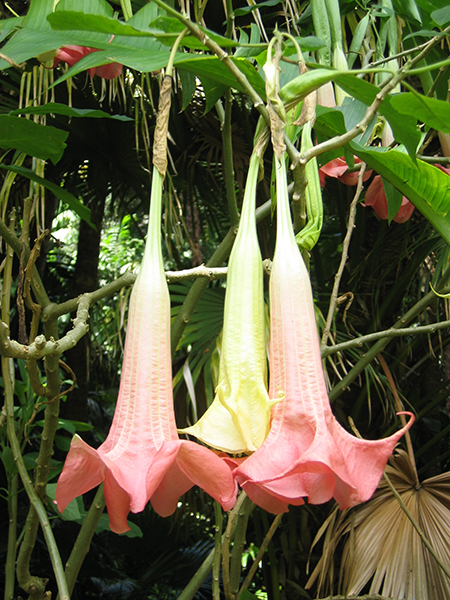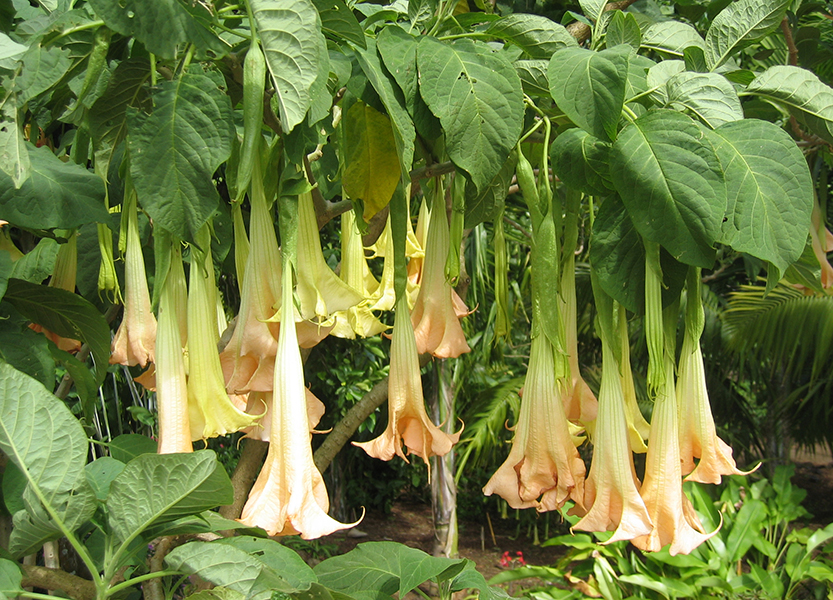Tropical Plant Database - Plant Details
Brugmansia ×candida
Conservation Status
- IUCN: Not Evaluated
- USFWS: None
Genus: Brugmansia
Species: ×candida
Species Author: Pers.
Vernacular: Angel's Trumpet [Lorence 6443]
Synonyms: Datura x Candida (Pers.) Saff. (D. aurea x Versicolor)'
Brugmansia ×candida is an evergreen shrub growing 10 to 20 feet tall. Young stems, leaves and calyx are almost glabrous or sparsely hairy in some forms. The downy, ovate leaves are very variable in size, reaching a maximum of about 16 inches long. This Angel's Trumpet grows fast and upright, often forming an umbrella-like canopy under which huge, 9-14 inch trumpet shaped flowers are produced. The hanging flowers have a wide range of colors--white through yellow, orange, apricot, and pink--and are sweetly musky scented. The calyx of the flower splits down one side. The fruit is smooth, narrowly spindle-shaped, and about 7 inches long. Brugmannsia ×candida is distinguishable from all other species by its fully pendulous flowers combined with the calyx concealing the basal narrow-most zone of the corolla tube. It most closely resembles B. versicolor, which differs in the distal part of the basal narrow-most zone of the corolla tube being exposed (A. Hay, pers. comm. 2006). The scent of Brugmansia flowers drifting in the air on warm summer evenings can only be described as exotic and intoxicating! The charm and the beauty of this highly ornamental genus are unique. (Bailey, L. H. and Bailey, E.Z. 1976. Hortus Third.) (Preissel, U. and Preissel, H. 1997. Engelstrompeten.)
Although the plant is poisonous, natives in Brazil smoke the leaves for a strong narcotic effect that it is said to relieve asthma. (Schultes, R. E. 1976. Ethnobotany.)
All parts of plant are poisonous if ingested or absorbed through the mucous membranes. Be careful to not rub your eyes after touching Brugmansia.
Brugmansia is native to South America, particularly the Andes, where it grows on sloping terrain under damp conditions. (Bailey, L. H. and Bailey, E.Z. 1976. Hortus Third.) (Preissel, U. and Preissel, H. 1997. Engelstrompeten.)
Brugmansia is named after Sebald Justin Brugmans (1763-1819). Even though Brugmansia has been in the USA for many many years, it has always been portrayed as a "Plant of Evil" and something undesirable to have growing in your yard. Not until 1997 did Brugmansia begin to gain the "serious" attention of many American plant collectors and home gardeners. (Bailey, L. H. and Bailey, E.Z. 1976. Hortus Third.) (Preissel, U. and Preissel, H. 1997. Engelstrompeten.)
Brugmansia ×candida is a hybrid between Brugmansia aurea with Brugmansia versicolor. This hybrid can be found growing wild in nature therefore it is a "natural hybrid". (Bailey, L. H. and Bailey, E.Z. 1976. Hortus Third.) (Preissel, U. and Preissel, H. 1997. Engelstrompeten.)
- 002935 - collected by Tim Flynn in 1988
- 002943 - collected by David H. Lorence in 1990
- 002939 - collected by David H. Lorence in 1990
- 002941 - collected by David H. Lorence in 1990
- 002938 - collected by David H. Lorence in 1990
- S078718 - collected by David H. Lorence in 1990
- 035959 - collected by Hank Oppenheimer in 2002
- 056251 - collected by Natalia Tangalin in 2007
- 084680 - collected by Kelsey Brock in 2016
We currently have 9 herbarium specimens for Brugmansia ×candida in our collection. Click on any specimen below to view the herbarium sheet data.
.svg)












